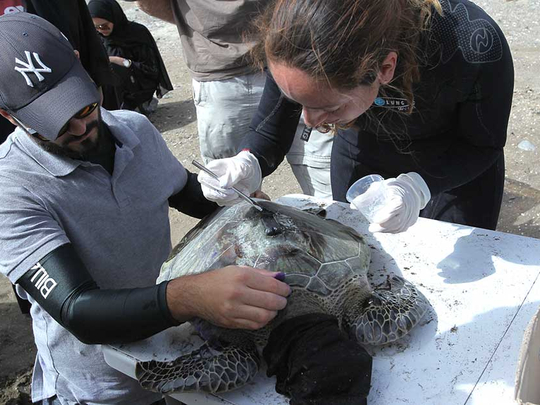
Sharjah: A new study is being launched to observe the natural behaviour and feeding habits of juvenile Green Turtles who live their early days in near-shore waters of Al Qurm mangroves, said environmental groups on Tuesday.
The Environment and Protected Areas Authority (EPAA) said in a statement that it is initiating the turtle study with Emirates Wildlife Society (EWS-WWF).
In order to carry out the study, environmental specialists from both organisations set out to capture and tag the turtles yesterday on Sunday at Khor Kalba, a nature reserve and mangrove swamp in Sharjah. Information from the study combined with other EPAA work will help shed light on the risks for turtles in the coastal zone and guide development of more detailed, actionable turtle conservation in the immediate future, officials said.
Environmentalists from the EPAA and EWS-WWF attached a satellite transmitter to one juvenile Green Turtle to track its movements for the next six months and also took tissue samples from Green Turtles for a genetic study. They also measured and documented all the turtles caught and developed a clear method for capture and sampling for future research work.
Hana Saif Al Suwaidi, EPAA chairperson, said that “juvenile Green Turtles feed in the waters of Al Qurm mangroves but it is unknown whether the turtles remain in the mangroves for most of their life, or leave daily to feed in the open ocean. It is unknown where these turtles were born or where they go when they become adults. Therefore, this study will help us to answer some of these questions.”
Al Suwaidi added the study will combine with other EPAA and EWS-WWF research in order to understand the importance of Al Qurm mangroves for turtle protection.
“It will also be the first attempt to gather long-term information on Green Turtle movements on the Sharjah east coast,” she said.
Once captured, the turtles are fitted with a tag that transmits information on movements to a satellite. EWS-WWF are providing the satellite transmitter with EPAA collaboration, and will use this study to gather more data for their long-term turtle research projects throughout the UAE.
“This day of catching and sampling turtles will also help guide future capture and sampling protocols as the project expands to gather data from multiple turtles. The project is among many launched by EPAA to protect the emirates’ environment and preserve the biodiversity for generations to come,” said Al Suwaidi.












